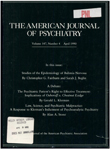Patterns of thought disorder associated with right cortical damage, schizophrenia, and mania
Abstract
The authors used the Thought Disorder Index to measure thought disorder in 23 patients with unilateral right hemisphere cortical damage, 20 patients with bipolar mania, and 25 patients with schizophrenia. There were no differences in the total amount of thought disorder in these groups, but each showed a unique pattern of thought disorder. Patients with right hemisphere damage displayed fragmented thinking, manic patients displayed playful thinking, and schizophrenic patients displayed idiosyncratic thinking. These findings support the view that thought disorder is manifested in different forms that are relatively specific to psychiatric or neurological condition.
Access content
To read the fulltext, please use one of the options below to sign in or purchase access.- Personal login
- Institutional Login
- Sign in via OpenAthens
- Register for access
-
Please login/register if you wish to pair your device and check access availability.
Not a subscriber?
PsychiatryOnline subscription options offer access to the DSM-5 library, books, journals, CME, and patient resources. This all-in-one virtual library provides psychiatrists and mental health professionals with key resources for diagnosis, treatment, research, and professional development.
Need more help? PsychiatryOnline Customer Service may be reached by emailing [email protected] or by calling 800-368-5777 (in the U.S.) or 703-907-7322 (outside the U.S.).



